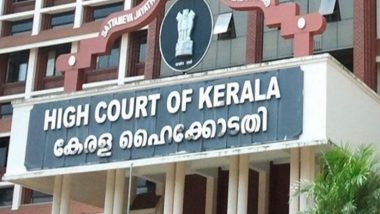New Delhi, Jun 1 (PTI) A vast swathe of the country experienced below-normal temperatures on Monday as many areas received rainfall due to a cyclonic activity in the Arabian Sea and the beginning of monsoon.
The southwest monsoon hit Kerala on Monday on its normal onset date, marking the commencement of the four-month-long rainfall season.
Also Read | Punjab National Bank Cuts Repo-linked Lending Rate by 40 Bps to 6.65% From 7.05%.
Scattered rains continued in northern states such as Punjab, Haryana, Uttar Pradesh and the desert state of Rajasthan due to a western disturbance which kept the heat wave at bay.
"No heat waves are likely over the country during next 5 days,” the India Meteorological Department said in a bulletin.
The national capital witnessed a partly cloudy sky and the maximum temperature settled at 35.4 degrees Celsius.
Wardha (Vidarbha) recorded the highest temperature in the country at 43.4 degrees Celsius, more than a notch down since Sunday when Khargone in Madhya Pradesh recorded 44.5 degrees Celsius.
The IMD said north India is likely to get "above normal" monsoon rainfall, while central India and the southern peninsula will receive "normal" rainfall. However, east and northeast India are likely to receive less rainfall than other parts of the country.
Several parts of Kerala received heavy to very heavy rains, especially Vatakara in Kozhikode, which recorded 15 cm of rainfall. A red alert was sounded for two days in the district. A red alert denotes likelihood of very heavy to extremely heavy rain.
While Vatakara received heavy rain, Quilandy, also in the district, received nine cm rainfall.
An yellow alert (possibility of isolated heavy rainfall) was issued for Monday in 10 districts and for seven districts on Tuesday, the bulletin said. Though Thiruvananthapuram received heavy rains in the morning, by noon it was bright and shiny.
Up north, Uttar Pradesh's capital Lucknow recorded a maximum temperature of 36.4 degrees Celsius, four notches below normal. Some parts of the state also witnessed rainfall with Ballia recording 7.3 mm and Gorakhpur 0.8 mm.
Banda was the hottest place in the state where mercury touched 41.6 degrees Celsius, followed by Jhansi (41.1 degrees Celsius) and Allahabad (40.8 degrees Celsius).
Many parts of Haryana and Punjab witnessed rains during the past two-three days and maximum temperatures continued to remain below the normal levels on Monday.
Chandigarh, the common capital of the two states, recorded a maximum temperature of 33.8 degrees Celsius, six notches below the normal.
In Haryana, Ambala's maximum temperature settled at 32.9 degrees Celsius, seven notches below the normal, while Karnal recorded a high of 32 degrees Celsius, eight notches below the normal.
Hisar's maximum temperature settled at 34.5 degrees Celsius, eight notches below the normal, while Narnaul registered a high of 35.5 degrees Celsius.
Ludhiana in Punjab recorded a high of 32.9 degrees Celsius, seven notches below normal limits.
Parts of Rajasthan witnessed rainfall accompanied with gusty wind, bringing respite from a sweltering heat on Monday.
Churu recorded 63.6 mm rainfall followed by 11.7 mm in Jaipur, 2.6 mm in Ajmer, 0.6 mm in Kota.
At 40.9 degrees Celsius, Kota was the hottest place in the state, followed by 40 in Jaisalmer, 39.8 in Bikaner, 38.5 each in Barmer and Churu.
Meanwhile, the IMD said a depression in the Arabian Sea is likely to intensify into a severe cyclone and cross the north Maharashtra and south Gujarat coasts on June 3.
The Gujarat government ordered evacuation of low-lying areas and deployed 10 National Disaster Response Force (NDRF) teams in over half a dozen districts.
The IMD warned that the cyclonic storm will bring in its wake heavy rains.
"We expect the cyclonic storm to hit the southern Gujarat coast near Daman on June 3 evening with a wind speed of 90 to 100 km per hour.
"It will bring heavy rainfall in the south Gujarat region on June 3 and 4. It may have some impact in Bhavnagar and Amreli districts of the Saurashtra region as well," said Director of MET Centre in Ahmedabad, Jayanta Sarkar.
Ahead of the storm, the weather of Bhavnagar suddenly changed on Monday as strong winds coupled with rain lashed the city in the morning.
The sudden thunderstorm uprooted trees as well as solar panels at some places in the district.
Reeling under a sweltering heat, Mumbai and its surrounding areas experienced a spell of light showers coupled with thunder and lightning in the morning following the formation of a low pressure area in the Arabian Sea.
Residents of these areas woke up to a cloudy sky and light showers and the weather remained pleasant throughout the day.
Dharavi, a slum pocket of Mumbai, recorded the highest 31.46 mm downpour in the past 24 hours, according to IMD's website.
Meanwhile, in adjoining Goa, people have been advised not to visit beaches or venture into the sea over the next two days as the IMD has predicted heavy rainfall in parts of north and south Goa districts with wind speeds of 45-55 kilometres per hour..
An advisory about high waves in the 2.8-4 metre range was also issued by Drishti Marine, a firm contracted by the state government to provide lifeguards at beaches.
(This is an unedited and auto-generated story from Syndicated News feed, LatestLY Staff may not have modified or edited the content body)














 Quickly
Quickly




















